sourdough discard sandwich bread :
Ever felt sad when your sourdough starter goes to waste? No more! This simple recipe turns that extra starter into a soft, fluffy loaf. It’s perfect for sandwiches and toast. With just a few ingredients and some time, you’ll make a bread that everyone will love.
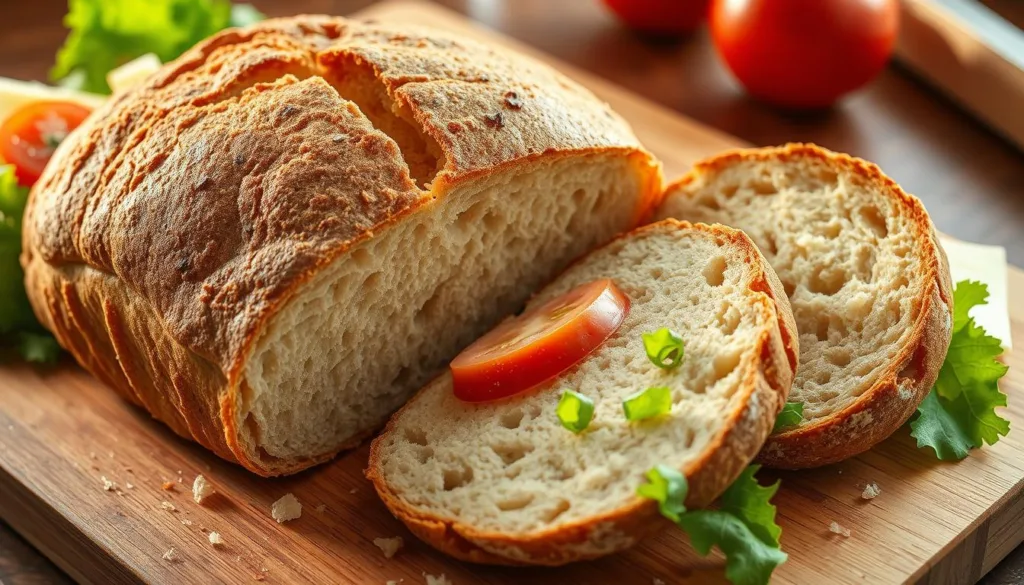
Table of Contents
Key Takeaways
- Transform your sourdough discard into a delicious sandwich bread
- Enjoy a soft, fluffy loaf with a subtle tang in just 2-3 hours
- Bake the bread in a standard or Pullman tin for a rounded or square top
- Freeze the bread for up to 3 months or keep it fresh for a week
- Customize the recipe with different flour variations like honey and oat, multigrain, or wholemeal
Understanding sourdough discard sandwich bread
This sourdough discard sandwich bread recipe is a mix of sourdough’s tang and commercial yeast’s ease. It uses your sourdough discard, adding flavor and texture to the loaf. This recipe is special because it brings sourdough benefits in less time than traditional methods.
Benefits of Using Sourdough Discard
Using sourdough discard in your bread has many perks. It adds a complex sourdough taste and a soft, tender texture. Plus, it’s good for the planet by reducing food waste.
Quick vs. Traditional Sourdough Methods
This recipe is faster than traditional sourdough, taking only 2 1/2 hours. It combines sourdough discard with commercial yeast for quick rising. This is perfect for those who love sourdough but don’t have all day to wait.
“This recipe is a game-changer for busy home bakers who love the taste of sourdough but don’t have the time for a traditional loaf.”
Essential Ingredients for Perfect Results
Making the perfect sourdough discard sandwich breadneeds the right mix of ingredients. At the core are the sourdough bread ingredients: active dry yeast, butter, honey or sugar, salt, sourdough discard, warm water, and all-purpose or bread flour.
The recipe asks for 100g of sourdough discard, 250g of water, 500g of bread flour, 10g of salt, 20g of sugar, 60g of butter, and 7g of active dry yeast. Make sure all ingredients are at room temperature before mixing for the best results.
- Active dry yeast: Gives the dough the leavening power it needs to rise and become light and airy.
- Butter: Adds richness and makes the bread’s crumb tender.
- Honey or sugar: Feeds the yeast, adds sweetness, and helps with browning.
- Salt: Boosts the flavor and balances the sweetness.
- Sourdough discard: Gives a tangy flavor and improves the bread’s structure and rise.
- Warm water: Activates the yeast and helps the dough come together smoothly.
- Bread flour: Provides the gluten needed for a sturdy, chewy crumb.
By carefully measuring and mixing these key sourdough bread ingredients, you’re on your way to making a loaf of sourdough discard sandwich bread . It will look great and taste amazing.
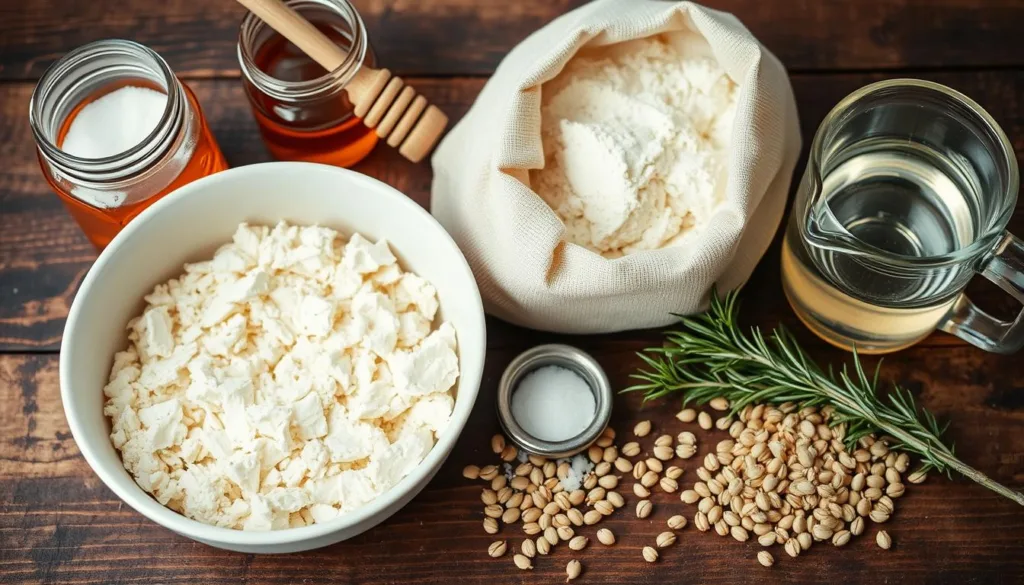
“The most important factor in making the perfect sandwich bread made of sourdough is the high-quality and the balance of essential ingredients. With the right proportions and attention to detail, you’ll be rewarded with a truly remarkable loaf.”
Required Equipment and Tools
To bake sourdough discard sandwich bread at home, you need some key tools. The right equipment makes the process smoother and helps you get great results.
Bread Tins and Pans
The pan or tin you use is crucial for your sourdough bread. A 4x8x4 inch bread tin or Pullman pan is perfect. It gives your loaf the right shape and size for a classic sandwich.
Mixing Equipment Options
For mixing the dough, you can choose a stand mixer with a dough hook or a Thermomix. These tools knead and mix ingredients fast. If you don’t have a stand mixer, a large bowl and a wooden spoon work too.
Additional Helpful Tools
- Digital scales for accurately measuring ingredients
- Large mixing bowl with a lid or towel for proofing the dough
- Rolling pin for shaping the dough
- Bench scraper for cutting and handling the dough
- Plastic bread bags for storing the finished loaf
- Bread slicing guide or electric knife for clean, even slices
With the right bread baking equipment, a stand mixer, and some other tools, you’re ready to bake delicious sourdough discard sandwich bread at home.
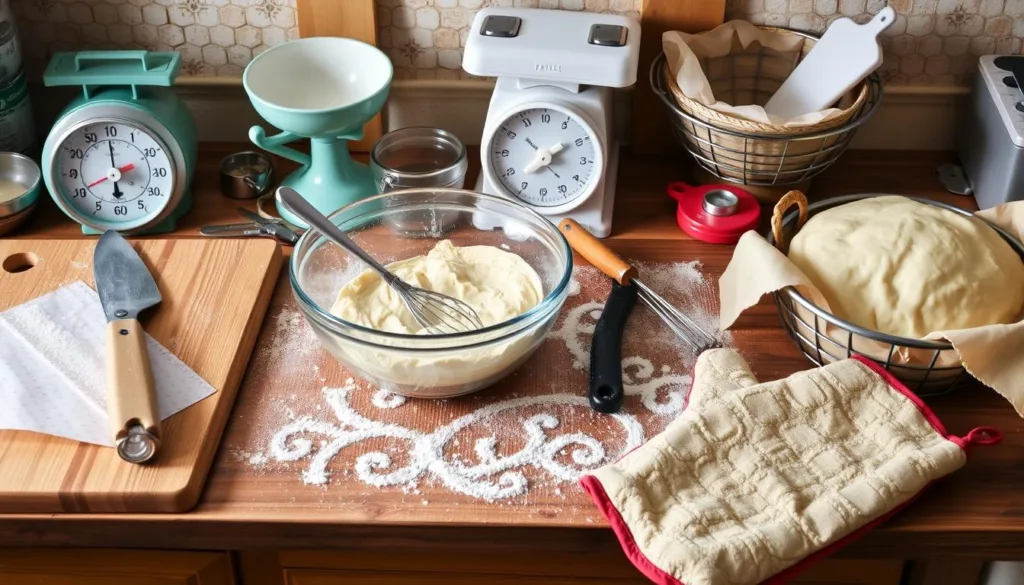
Step-by-Step Mixing Process
Making sourdough discard sandwich bread is easy, whether you use a stand mixer or a Thermomix. Start by mixing the sourdough discard, water, and flour in your chosen vessel. Let it rest for 30 minutes.
Then, add the salt, sugar, butter, and yeast. Knead the dough for 3-6 minutes until it’s elastic and sticks to the bowl.
If you’re using a Thermomix, the dough function is perfect for the right texture. The dough should be stretchy and pliable, ready for the next step in the dough mixing technique.
- In a stand mixer or Thermomix, combine the sourdough discard, water, and flour.
- Let the mixture rest for 30 minutes.
- Add the salt, sugar, butter, and yeast.
- Knead the dough for 3-6 minutes until it becomes elastic and slaps the sides of the bowl.
- For Thermomix users, use the dough function to get the desired texture.
- The dough should pass the windowpane test, showing it’s stretchy and pliable.
| Ingredient | Quantity |
|---|---|
| Water | 1 cup (240 grams) |
| Active dry yeast | 2 ¼ teaspoons (7 grams) |
| Sourdough discard | ½ cup (140 grams) |
| Honey | 2 tablespoons (42 grams) |
| Butter | 2 tablespoons (28 grams) |
| All-purpose flour | 3 cups (360 grams) |
| Kosher salt | 1 teaspoon (3 grams) |
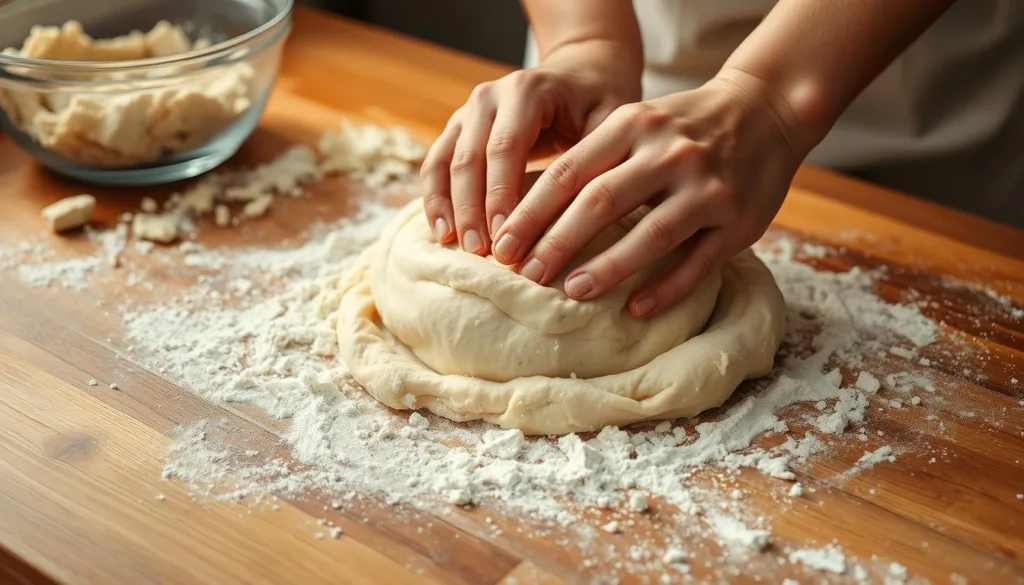
“The key to a successful sourdough discard sandwich bread lies in the dough mixing technique. Achieving the perfect texture through proper kneading is essential for a soft, yet sturdy crumb.”
Mastering the Dough Consistency
Getting the dough just right is key for a great sourdough sandwich bread. You want it smooth and elastic, a bit sticky but not too much. If it’s too wet, add flour slowly until it feels right.
The dough should be stretchy enough to see through without breaking. This is called the windowpane test.
Tips for Perfect Dough Texture
- Use a high-quality bread flour for optimal gluten development and structure.
- Knead the dough for 10-15 minutes by hand or 10 minutes with a mixer on low speed to build up the elasticity.
- Incorporate the sourdough discard gradually, ensuring even distribution throughout the dough.
- Utilize the warmth of your hands to gently work the dough, rather than overmixing, which can lead to a tough texture.
Troubleshooting Common Issues
Having trouble with your dough? There are easy fixes. Over-fermentation makes the dough too wet. Watch the fermentation time and adjust it for your kitchen’s temperature.
Also, greasing the bowl with soft butter helps the dough’s texture. It spreads the fat evenly.
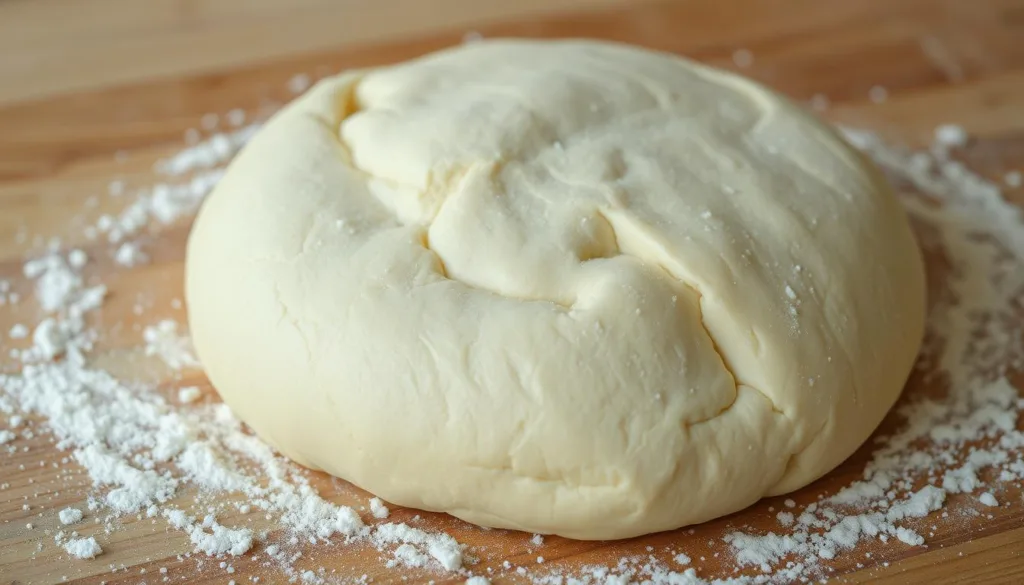
“The perfect sourdough sandwich bread dough should be slightly tacky, with a smooth, elastic texture that’s a pleasure to work with.”
Proper Fermentation and Rising Techniques
To make the perfect sourdough sandwich bread, you need to master fermentation and rising. After kneading, let your dough go through a bulk fermentation. This step makes it double in size and adds flavor.
The dough for this recipe takes 10-12 hours to rise at 68°F. If your kitchen is hot then it could rise more quickly. During this time, the dough should double in size, which usually takes 10-12 hours at room temperature.
Once it’s risen, shape the dough into a loaf. Then, let it rise again in the bread pan. This second rise can last 1 1/2 to 2 hours or more, depending on the temperature and starter amount.
Watch the dough closely to see if it’s ready for baking. It should rise just above the bread pan’s rim. This means it’s ready for the oven.
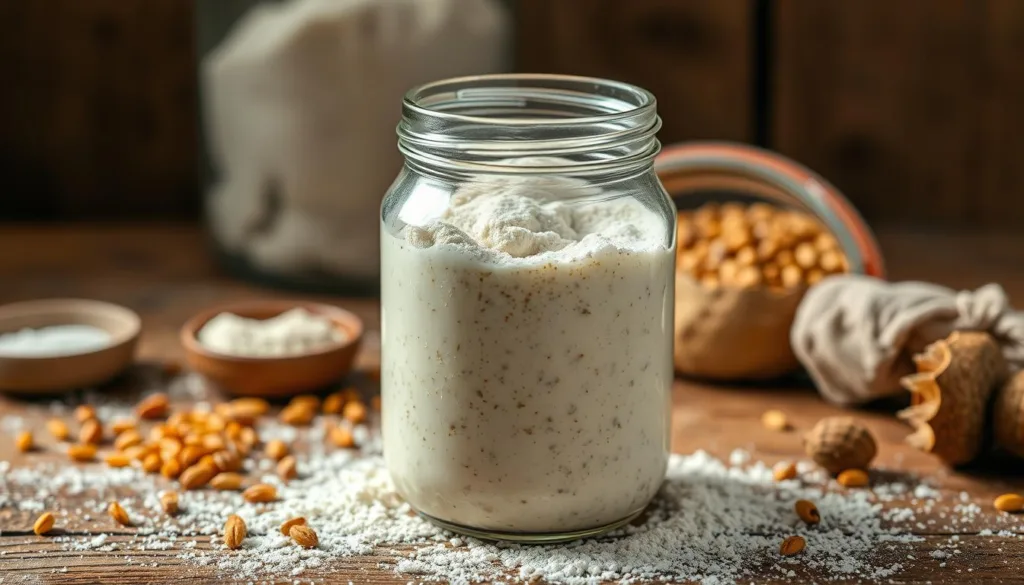
“The key to a successful sourdough sandwich bread is patience and attention to the dough’s fermentation and rising process. Take the time to let the bread develop its full flavor and texture.”
Rise times can change due to the starter’s strength, your home’s temperature, and the flour type. Adjust the times as needed to get the best results.
Shaping Your Sandwich Loaf
Shaping your sandwich bread is key to getting the perfect rise and texture. The method you use greatly affects the final loaf. Let’s explore how to shape your sourdough discard sandwich bread to perfection.
Creating the Perfect Roll
To shape your dough into a well-formed loaf, start by placing it on a lightly floured surface with the smooth side down. Gently shape it into a rectangle, being careful not to overwork it. Then, tightly roll the dough from one end to the other, forming a uniform log.
Make sure to tuck the ends under as you roll to keep the shape.
Achieving Proper Tension
The right amount of tension on the top of the dough is crucial for a well-shaped loaf. As you roll the dough into a log, gently pull it towards you. This ensures the surface of the loaf is smooth and taut.
This tension helps the dough rise evenly and keeps its shape during baking.
Once shaped, place the dough seam-side down in a greased loaf pan. This method ensures a beautifully-shaped loaf with a consistent rise and a lovely, golden-brown crust.
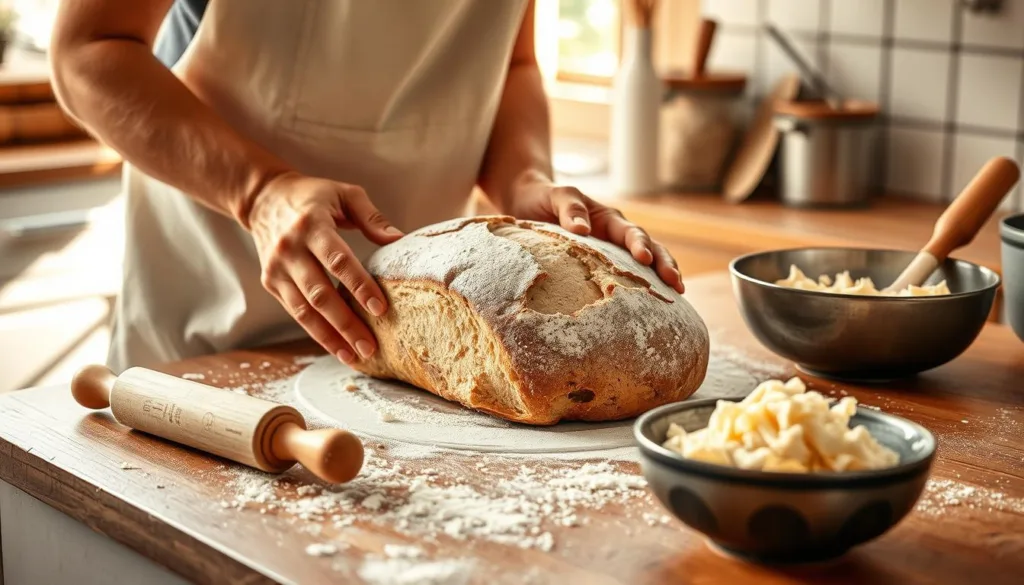
Remember, the proper shaping of your sourdough discard sandwich bread is essential for achieving the perfect texture and rise. By mastering this technique, you’ll be able to consistently produce delicious, bakery-quality loaves right in your own kitchen.
Baking Instructions and Temperature Guide
To bake a perfect sourdough discard sandwich bread , preheat your oven to 375°F (190°C). This temperature helps your bread get a golden, crisp crust. It also keeps the inside soft and tender.
After your oven is ready, put your dough in a 10 x 5-inch loaf pan. Bake for 40-45 minutes. Watch the bread closely because baking times can differ. The bread is done when its inside reaches 195-210°F (90-99°C).
To add a shine and crisp crust, brush the dough’s top with a beaten egg before baking. This gives it a beautiful, glossy look. The bread should cool in a rack of wire prior to cutting. For a softer crust, brush it with melted butter right after baking.
FAQ
What makes this sourdough discard sandwich bread recipe unique?
This recipe combines sourdough’s tang with the ease of commercial yeast. It uses sourdough discard to add flavor and reduce waste. It’s quick, taking just a few hours, unlike traditional sourdough that takes a full day.
What are the benefits of using sourdough discard in this recipe?
Using sourdough discard gives the bread a subtle sour flavor and a soft texture. It also helps use up excess starter, cutting down on waste.
What are the key ingredients in this recipe?
The main ingredients are active dry yeast, butter, honey or sugar, and salt. You also need sourdough discard, warm water, and all-purpose or bread flour.
What equipment is needed to make this sourdough discard sandwich bread?
You’ll need a 4x8x4 inch bread tin or Pullman pan. Also, a stand mixer with dough hook or Thermomix, digital scales, and a large bowl with a lid. Tools like a rolling pin, bench scraper, and plastic bread bags for storage are also useful.
How do you mix and knead the dough for this recipe?
Mix the sourdough discard, water, and flour in a stand mixer or Thermomix. Rest for 30 minutes. Then, add the salt, sugar, butter, and yeast. Knead for 3-6 minutes until the dough is elastic and passes the windowpane test.
How do you ensure the perfect dough consistency?
Aim for a smooth, elastic dough that’s slightly sticky but doesn’t stick to the bowl. If it’s sticky, you can add flour one tablespoon at each amount at a. Avoid over-fermentation to prevent a wet, sloppy dough.
How do you properly ferment and rise the dough?
After kneading, let the dough rise in a greased bowl for 1-2 hours or until doubled in size. For the second rise, shape the dough and let it rise in the bread pan for 30 minutes to an hour, or until it’s just above the rim of the tin.
How do you shape the dough into a sandwich loaf?
Place the dough on a countertop with the smooth side down. Gently form a rectangle, then roll tightly into a log. Tuck the ends under and create tension on the top by pulling the dough towards you. Place the seam-side down in the buttered tin.
What are the baking instructions and temperature guide for this recipe?
Preheat the oven to 375°F (190°C). Bake for 40-45 minutes or until the internal temperature reaches 195-210°F (90-99°C). For a shiny crust, brush the bread with beaten egg before baking. For a softer crust, brush with melted butter after baking.


